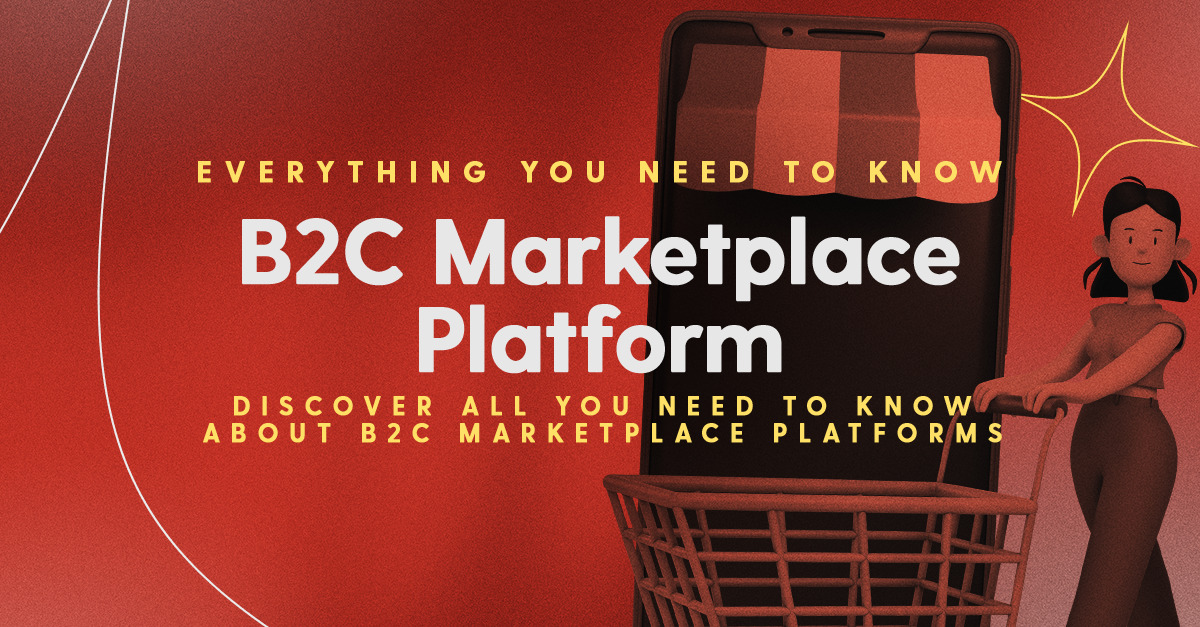B2C marketplace platforms are amongst the most highly valued of internet businesses.
For example, Amazon, Instacart, Zillow each have a market capitalization of more than a billion dollars. These B2C marketplace plaforms primary function is to connect businesses that want to sell products or services to potential customers (B2C).
In 2025, online marketplace platforms are booming, with companies like Etsy, Zillow, and Fiverr generating billions in revenue.
They have low setup costs, do not require any inventory to get started and can experience exponential growth through two sided marketplace network effects.
The secret? Scalability, network effects, and the right business model.
If you’re thinking about starting a B2C marketplace, this guide will show you:
– What is a B2C marketplace platform & how it works
– B2C marketplace business models that generate revenue
– How to build a marketplace website from scratch
– The best marketplace platforms & tools to launch fast
– How to scale your marketplace and drive growth
What is a B2C marketplace platform?
A B2C marketplace platform is a type of online marketplace that facilitates the sale of products and services from businesses to consumers (B2C).
You can think of a B2C marketplace platform as something similar to a shopping mall. As with the shopping mall, B2C marketplaces aggregate competing sellers in one location benefiting both businesses and consumers.
On the one hand, consumers benefit by being able to go to one place where they can find reliable suppliers, compare prices, negotiate terms and make purchases quickly and securely. Meanwhile, sellers are able to get much more business when they co-locate with competitors since they benefit from higher numbers of visitors to their store. (More on this later.)
Different types of B2C marketplace platform
There are three main types of B2C marketplace platform. These include:
- B2C product marketplaces for the buying and selling of physical, digital or downloadable products
- B2C service marketplaces for the buying and selling of services.
- B2C rental marketplaces connecting providers and renters together.
Understanding the type of B2C marketplace you’re looking to develop is crucial as each type of marketplace has a different strategy for building, launching, and scaling.
Pros and challenges of a B2C marketplace platform
In this section we take a look at the pros and challenges of building a B2C marketplace platform.
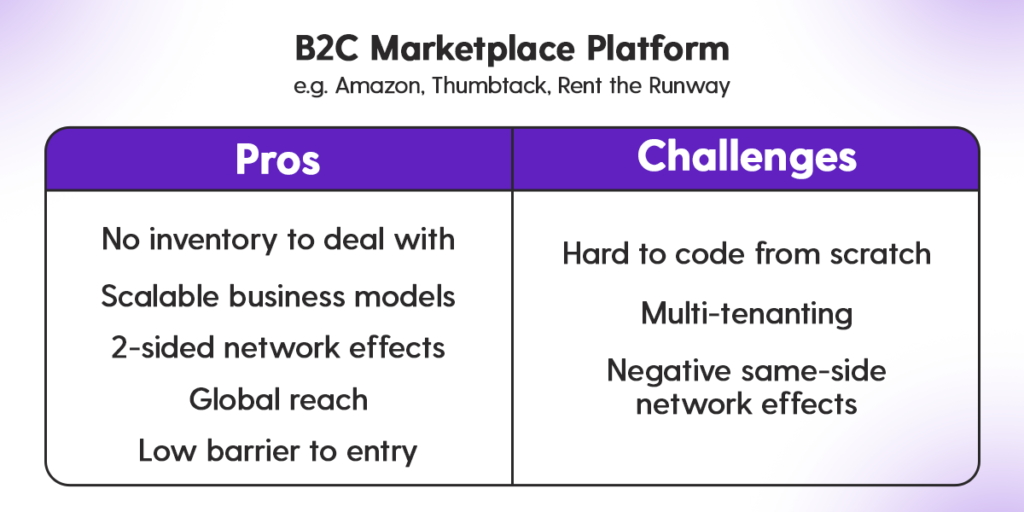
Pros of a B2C marketplace platform
Building a B2C marketplace platform can be highly lucrative. In this section we examine what are some of the pros of building a B2C marketplace platform.
No inventory to deal with
A B2C marketplace platform does not need to own a lot of inventory. This reduces the financial risk and operational burden for the B2C platform owner since, instead of investing in purchasing and storing inventory, the platform can focus exclusively on facilitating transactions between businesses and consumers.
Without the need for inventory B2C platforms are also far more scalable than the traditional single vendor ecommerce stores. This is because the B2C marketplace platform can expand its offerings without the constraints of inventory management.
Scalable business models
There are several scalable marketplace business models that can be used by a B2C marketplace platform. Multiple monetization models can be implemented, including commission-based models, subscriptions, listing fees, or lead fees..
The most common model is the commission model where the B2C marketplace platform takes a fee for each transaction that takes place on the marketplace. This model is highly scalable since the more transactions that take place, the more commission is generated by the B2C marketplace platform.
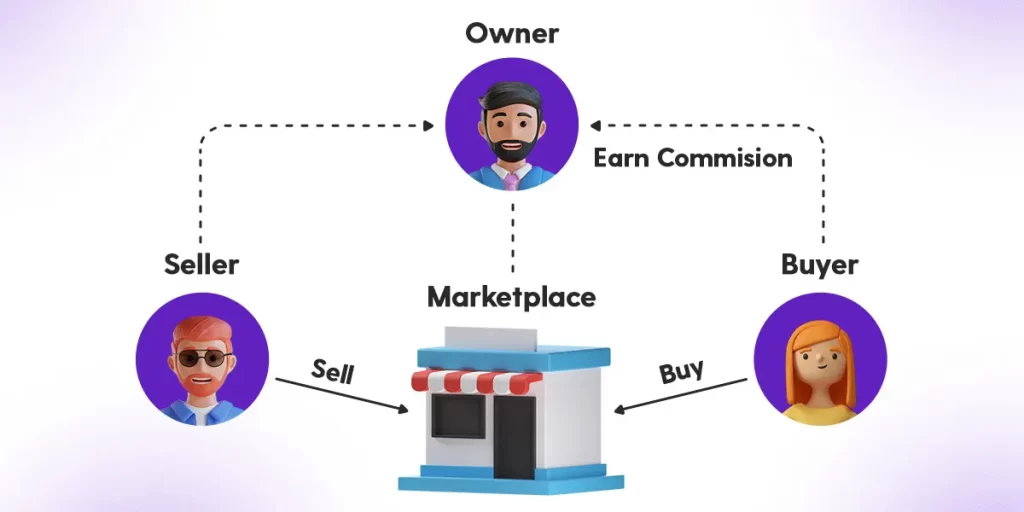
2-sided network effects
In its most basic form, a network effect can be defined as a phenomenon whereby a product or service gains additional value for each new user of the network.
The classic example is the telephone.
When there is only one telephone, there is no value to it as there is no one else to telephone. However, the more people who have a telephone the more valuable it becomes.
There are many different types of network effect. For example physical, protocol, personal utility and so on. B2C marketplace platforms benefit from a type of network effect called “2-sided network effects”.
2-sided network effects are characterized by two different classes of users: supply-side (sellers) and demand-side (buyers). Each of these user types come to the marketplace for different reasons and in doing so produce complementary value for the other side. For instance, each new business on a B2C marketplace like Amazon directly adds value for consumers by increasing the number and variety of products or services available. Similarly, each additional buyer is a new potential consumer for sellers.
Once established, 2-sided network effects are very difficult to disrupt. This can give a deep layer of defensibility to your business.
Essentially, for a new entrant to disrupt a B2C marketplace that has achieved 2-sided network effects, they must offer a better value proposition for both buyers and sellers simultaneously, or else nobody moves. What people have realized is that the value of the marketplace is in the network, not in a souped-up, ever changing interface. This is why B2C marketplaces like Netflix look almost unchanged after many years.
2-sided network effects can cause exponential growth for marketplaces that are run well and that have a good marketing strategy in place. This is because your target market can bring in more of your target market. This is known as a marketplace flywheel effect.
Global reach
B2C marketplace platforms can reach anyone in the global population who uses the internet. As such, they have huge revenue potential. However, keep in mind that there are technical and logistical challenges with facilitating cross border transactions.
Low barrier to entry
Building a B2C marketplace has never been easier. This is primarily due to advances in marketplace technology. These advances have significantly lowered the technical barrier to entry. Whilst in the past it would have cost between $50,000 – $250,000 to build a B2C marketplace, nowadays there exists off-the shelf marketplace template solutions, no code marketplace builders and cloud based infrastructure that can significantly lower the barrier to entry for early stage businesses and SMEs.
Challenges of B2C marketplace platforms
Let’s take a look at some challenges faced by B2C marketplace platforms and how to mitigate them.
Hard to code from scratch
Building a B2C marketplace platform from scratch is incredibly expensive and time consuming.
To be successful you will need to hire a team that has experience developing different types of marketplace including a B2C marketplace platform. This will include (at a minimum) a product manager, project manager, frontend developer, backend developer and infrastructure engineer. Typically the cost of building version 1 of a B2C marketplace can cost anywhere from $50,000 – $250,000 depending on the team you hire, feature sets included and so on.
Whilst this price is unaffordable for many startups and more mature organizations, marketplace technologies like Dittofi offer fully developed B2C marketplace templates that can be used to build and launch in a fraction of the time and cost of traditional development.
Multi-tenanting
A major challenge for B2C marketplace platforms to contend with is “multi-tenanting”.This occurs when people sell products or services on multiple B2C marketplace platforms at the same time. Think about businesses who list their products on both Amazon and Etsy at the same time.
When members of your network post the same products or services on competing B2C marketplace platforms, this makes it hard to lock out competition from new entrants, without a penalty. The goal is therefore to provide so much value through your B2C marketplace platform (especially to businesses) that they will not be tempted to multi-tenant.
Negative same-side network effects
Another challenge for B2C marketplace platforms are negative same-side network effects. These refer to the impact caused by adding a new user to the same side of the marketplace. For example, how does adding a new seller impact existing sellers?
Most of the time same-side users will subtract value from each other. For example, when lots of buyers all request Uber drivers at the same time, this leads to surge pricing which makes Uber drivers more expensive for all buyers. In the same way, an oversupply of Uber drivers means that the drivers are unable to earn as much since there are fewer trips avaliable.
These negative same-side network effects are usually outweighed by positive effects. For instance, in the 1980s shopping malls in the US witnessed that by aggregating competing businesses together in the same space, sellers were able to get an uptick in business than when they were spread out, making it practical for competitors to co-locate.
Examples of B2C marketplace platforms
Let’s take a quick look at some examples of B2C marketplace platforms in the product, service and rental spaces.
Amazon, a product based B2C marketplace platform
Amazon is a B2C product marketplace platform that connects businesses (sellers) directly with consumers (buyers). This model is as close to a physical shopping mall as we can see online. The solution hosts many different competing sellers each presenting their products to a global audience of consumers.
It’s worth noting that while Amazon is primarily a B2C marketplace platform, it also incorporates elements of a customer to customer (C2C) marketplace platform where individual sellers can list their products for sale.
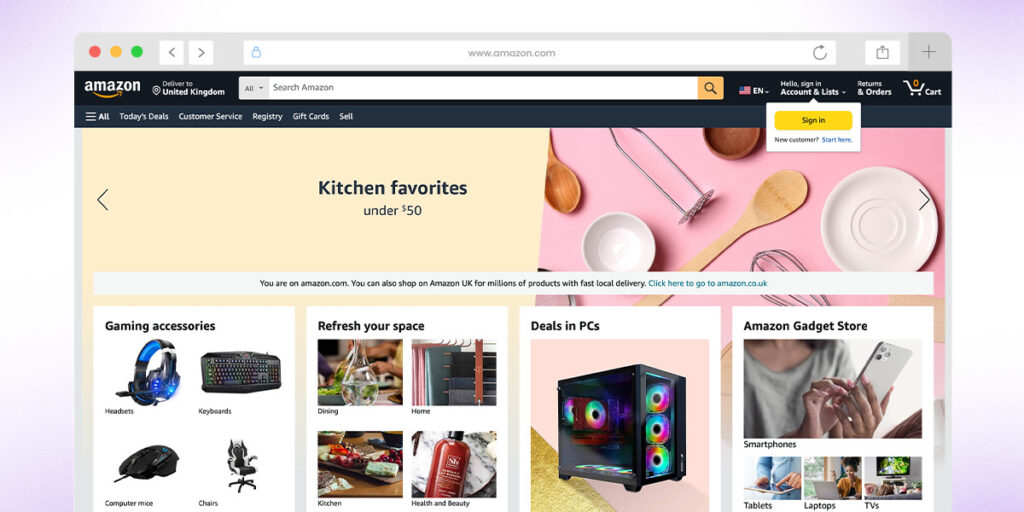
Thumbtack, a service based B2C marketplace platform
Thumbtack is a B2C service marketplace platform that connects local service professionals with individuals seeking services such as home improvements, event planning, tutoring, and more.
Through Thumbtack, users can easily find and hire trusted professionals for their specific needs, streamlining the process of sourcing services and facilitating seamless transactions between businesses offering professional services and consumers.
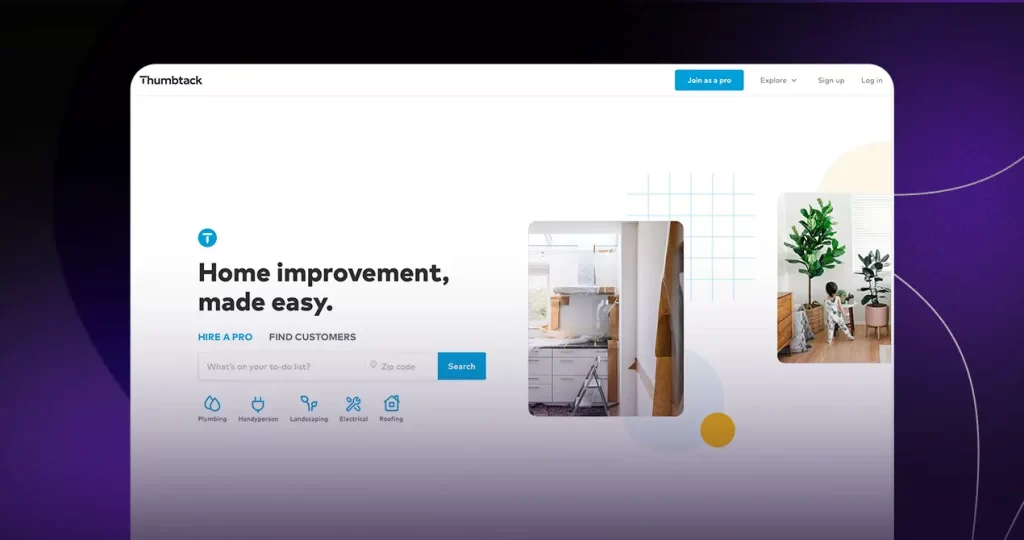
Rent The Runway, a rental based B2C marketplace platform
Rent The Runway is a B2C rental marketplace platform that connects fashion enthusiasts with designer clothing and accessories for rent.
Through Rent The Runway, individual consumers can access a vast selection of high-end apparel and accessories for various occasions, without the need for large upfront investments. The platform enables individuals to rent fashionable items for a fraction of the retail price directly from businesses. This model provides consumers with access to luxury fashion while promoting sustainability through the sharing economy model.
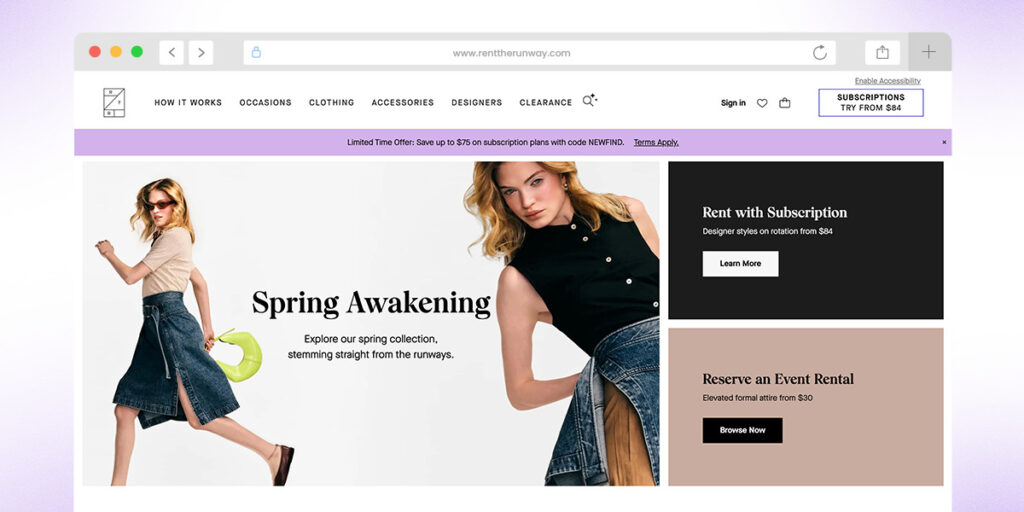
Essential features for a B2C marketplace platform
B2C marketplace platforms require a distinct set of features when compared to traditional ecommerce stores. As such, platforms like WooCommerce, BigCommerce, Shopify etc. do NOT work well for B2C marketplaces.
If you’re looking to build a B2C marketplace platform, we recommend that using a specialist marketplace technology. These platforms provide plenty of options to build complex, feature rich B2C marketplace quickly and affordably.
At Dittofi we have our own no code marketplace technology which we deliver through our visual development studio. Using Dittofi you can quickly and easily install a template B2C marketplace platform (product, service or rental). You can then customize the marketplace either by exporting the code and handing it off to a developer, or by using our visual development studio which enables you to edit the source code for your B2C marketplace in an entirely visual way.
Dittofi’s baseline B2C marketplace template includes all of the must have features for a successful B2C marketplace; these include the following.
Buyer and seller landing pages
Every B2C marketplace needs at least two landing pages: one for businesses and one for consumers. The purpose of these landing pages is to clearly communicate the value proposition of your marketplace to potential buyers and sellers.
Below are examples of the buyer and seller landing pages for the B2C marketplace platforms Amazon and Thumbtack.
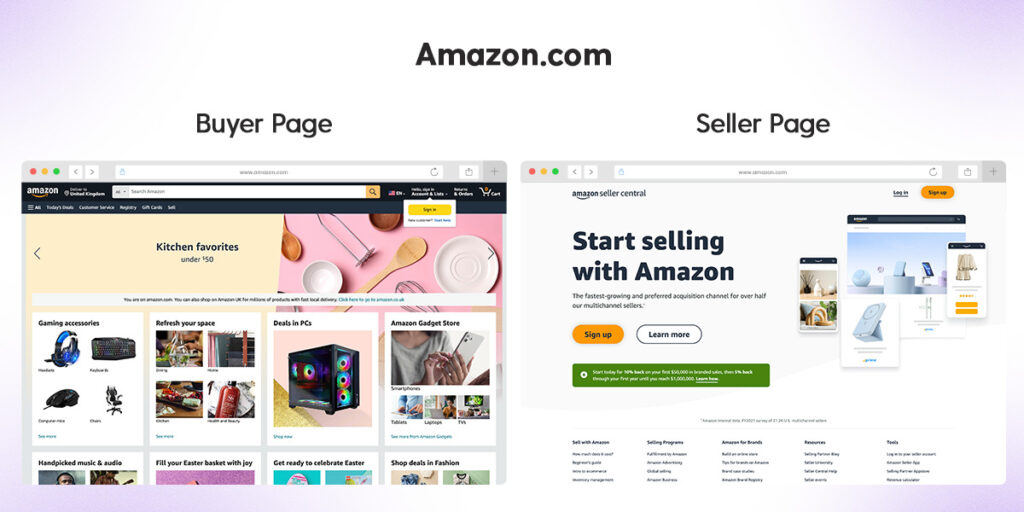
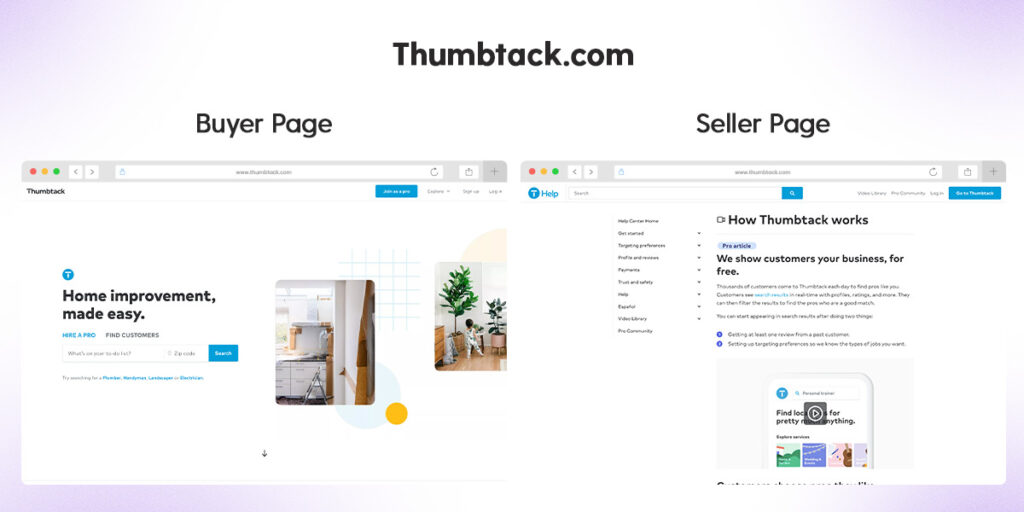
Dittofi’s B2C marketplace template gives you two different buyer and seller landing pages that you can quickly and easily customize for your unique value proposition.
User onboarding and sign up forms
Every B2C marketplace has two types of users: businesses (sellers) and consumers (buyers). Both businesses and consumers need to be onboarded differently, therefore Dittofi has developed two sets of onboarding forms that include single sign on features e.g. sign up with Google.
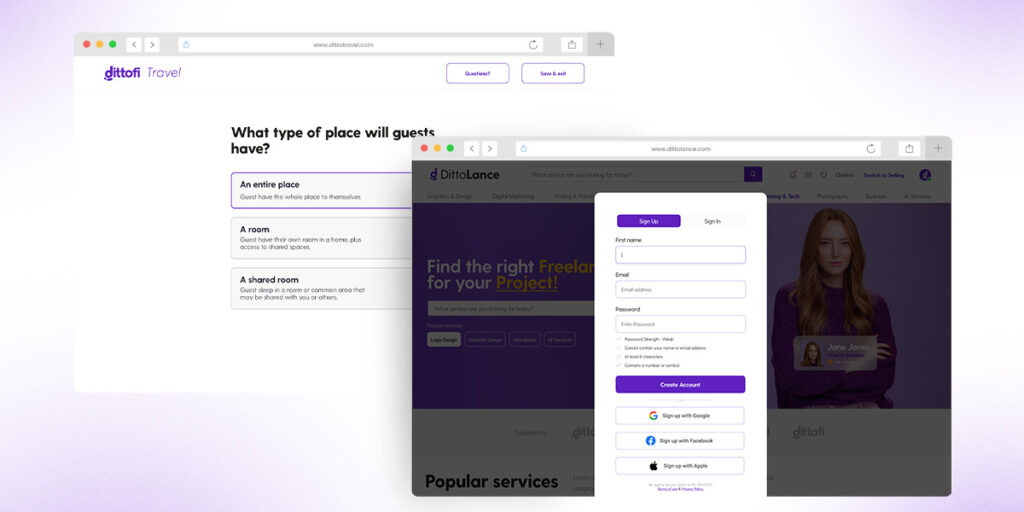
User profiles
Buyer and seller user profile pages should be automatically created when users sign up to your B2C marketplace. Each user profile should display personal information about the business or individual. All of this needs to be done in a way that keeps the user data secure & is compliant with any legal requirements such as GDPR. User should then be able to update and soft delete the information on their user profile.
Below is an example of Dittofi’s user profile pages.
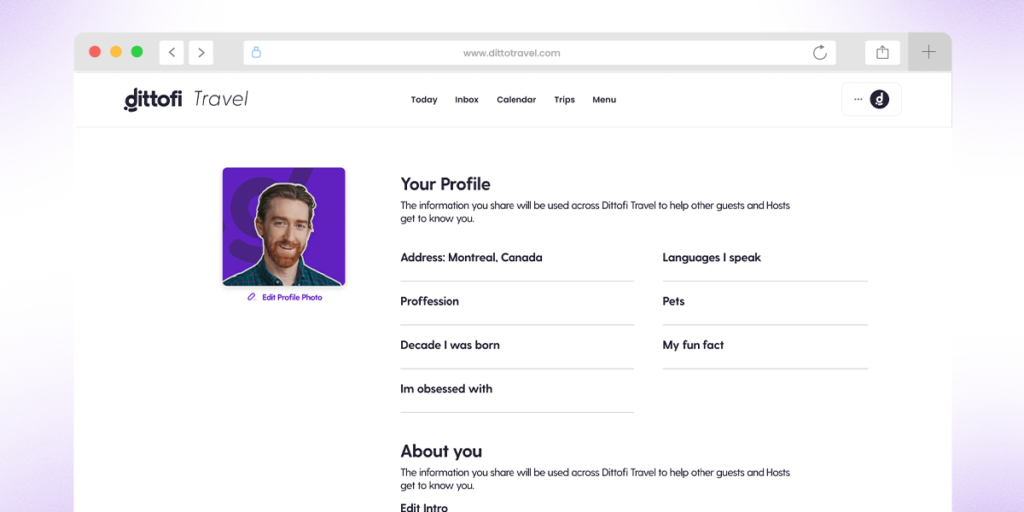
Routing pages (listing and listing results page)
Routing pages such as listing and listing results pages, play a crucial role in product or service selection on a B2C marketplace. The purpose of listing and listing results pages are so that customers can browse lists of products and services, compare options, bookmark favourites and make purchase decisions. Your listings and listing results pages should be designed to support these important tasks.
Below is an example of Dittofi’s listing and listing results pages.
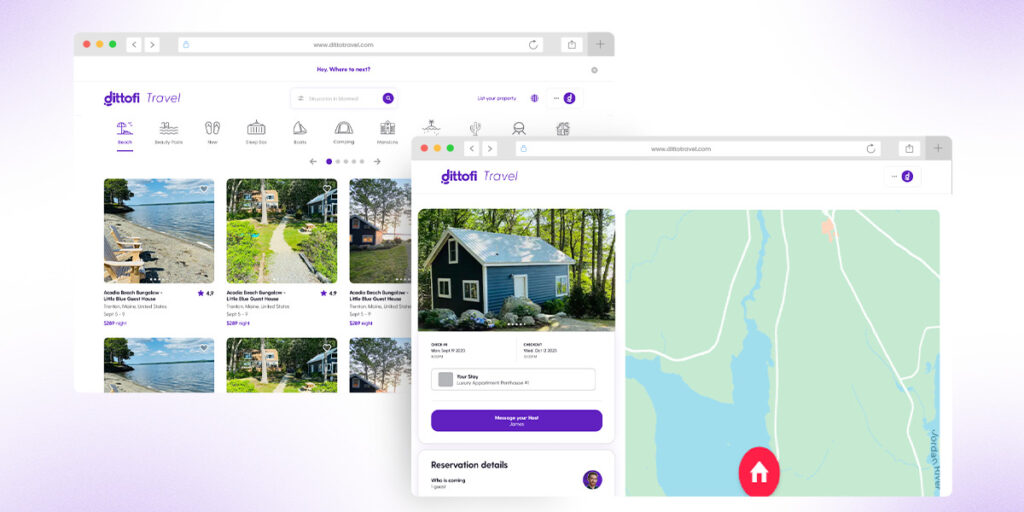
Listing details pages
The listing details pages give buyers on your B2C marketplace a detailed view of each individual listing. Buyers click on the listing which registers an intent to either purchase or rent a specific product or service. Notice that the listing details page should be attractive, functional and maximize the potential for lead generation through public searches.
Below is an example of a listing page built on Dittofi.
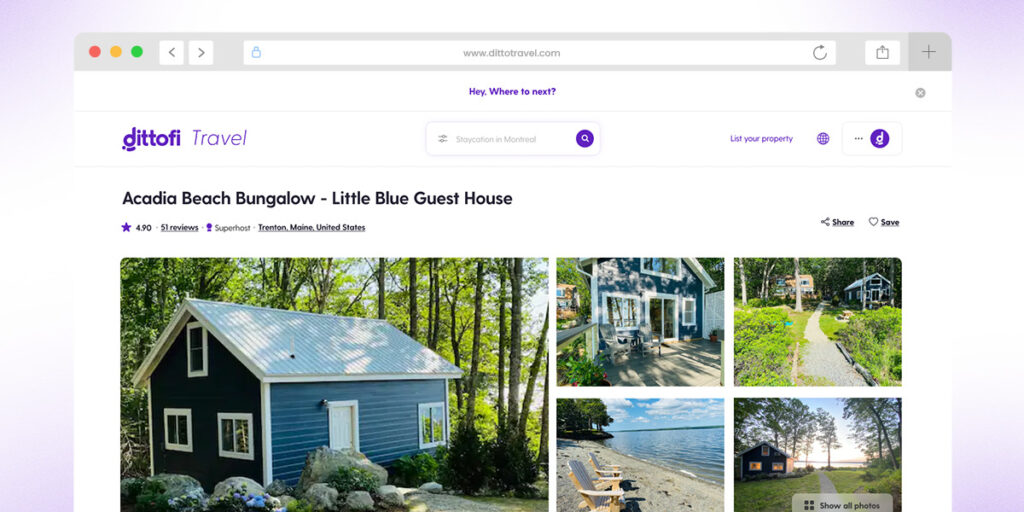
Easy search and navigation
B2C marketplace platforms have a lot of different products and services. To help buyers easily navigate your B2C marketplace you need to organize your products and services into different categories. These can be used by your users like pre-set filters to find groups of products or services.
It’s also important to text (keyword) search and a location based search, which is typically found in the marketplace navigation bar. Dittofi’s B2C marketplace template comes with all of these features included.

Secure payments
One of the main goals of a B2C marketplace platform is to generate a sustainable form of income for the platform operators. Dittofi’s B2C marketplace template includes a secure method of taking payments via popular payment gateways such as Stripe. The solution also handles payouts to businesses with advanced features such as a multi-vendor shopping cart, that are not common amongst other marketplace technologies.
Two-sided reviews
One of the hardest things to do when launching a new marketplace is to build trust between buyers and sellers. One of the simplest ways to build trust is a reviews feature. Most B2C marketplaces use a double blind review mechanism where the seller and buyer can provide feedback on their transaction experience without seeing each other’s reviews until both parties have submitted their feedback. This ensures unbiased and honest reviews, fostering trust and transparency in the marketplace ecosystem.
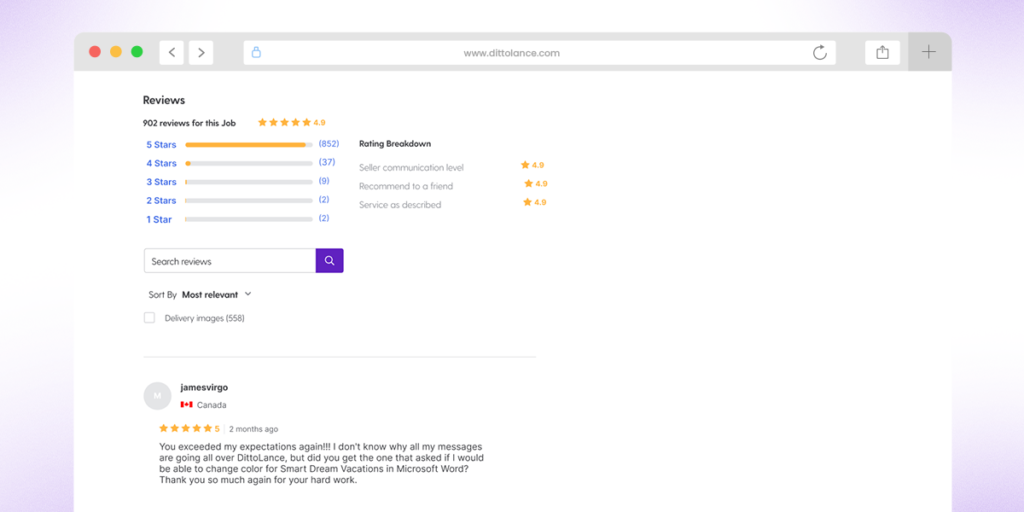
On platform chat
Offering buyers and sellers the option to communicate on the B2C marketplace can help speed up transactions, reduce marketplace leakage and give marketplace operators a way to audit communications between marketplace counterparts.
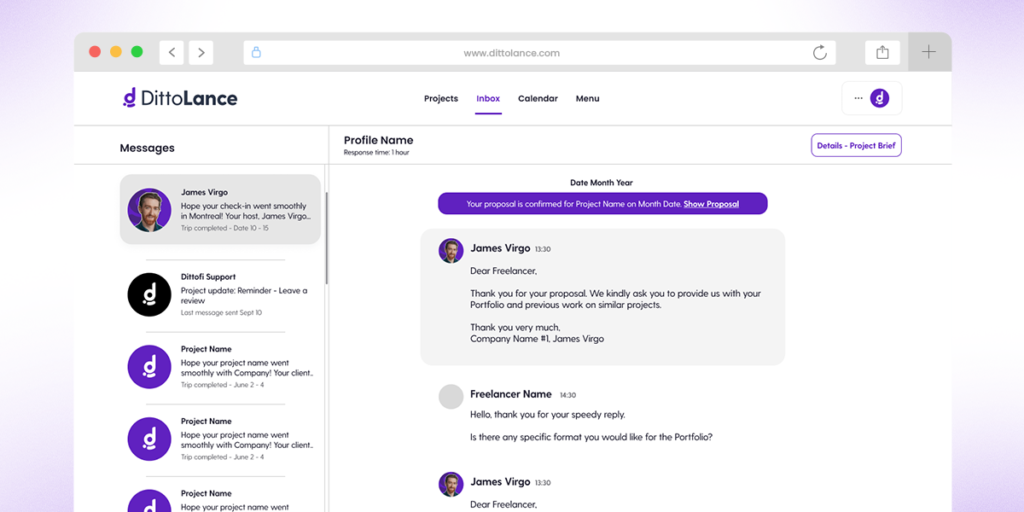
Manage listings
The “manage listings” page on a B2C marketplace platform serves as a dashboard for users (typically sellers) to control and administer their listings on the platform. Their primary purpose is to empower sellers with tools and features to efficiently manage and optimize their offerings.
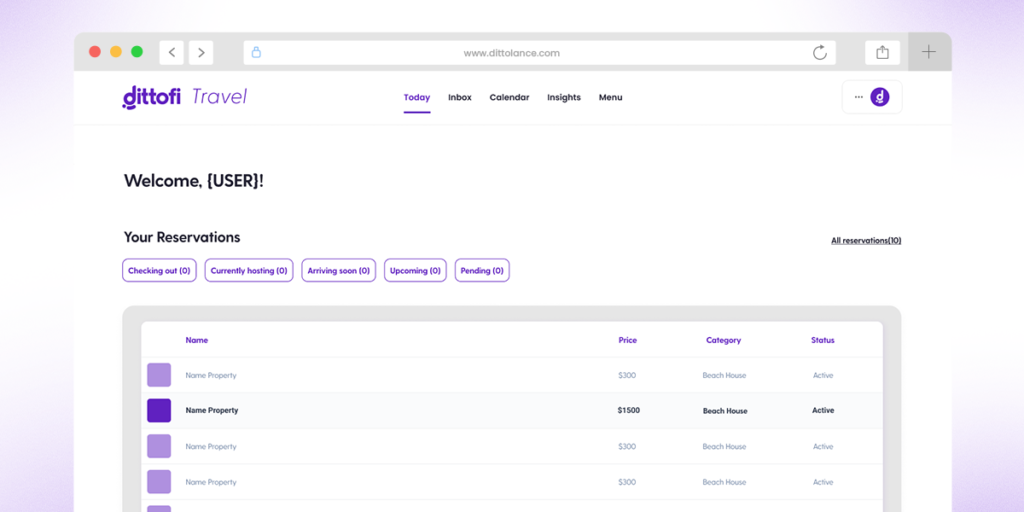
How to build a B2C marketplace platform
At Dittofi we’ve helped hundreds of founders and businesses launch B2C marketplace solutions and other apps.
In this section we are going to give you the steps to build a new B2C marketplace platform. These are:
- Find an idea for a B2C marketplace platform
- Validate your B2C marketplace idea
- Choose a B2C marketplace business model
- Choose your tech stack
- Build your B2C marketplace MVP
- Learn and grow
Please note. A step by step guide is only useful as a framework on how to build a B2C marketplace platform. The ultimate success of your B2C marketplace is down to your own determination, positivity and commitment to learn and grow.
Step 1. Find an idea
Great businesses solve real-world problems, and the same principle applies to B2C marketplace platforms. However, in the case of B2C marketplaces, these platforms are designed to address challenges for both buyers and sellers by facilitating connections between them.
Consider Amazon’s origins: Recognizing the growing trend of online shopping. Amazon founder Jeff Bezos saw that individual customers needed access to a wider choices of books than could be found in physical stores. Meanwhile, local book stores lacked an online presence.
To empower book stores and meet the needs of individual consumers, Bezos launched Amazon, a website where books could be listed and purchased online. As a result, individual consumers got access to a vast selection of books from various sellers, all conveniently available for purchase with just a few clicks.
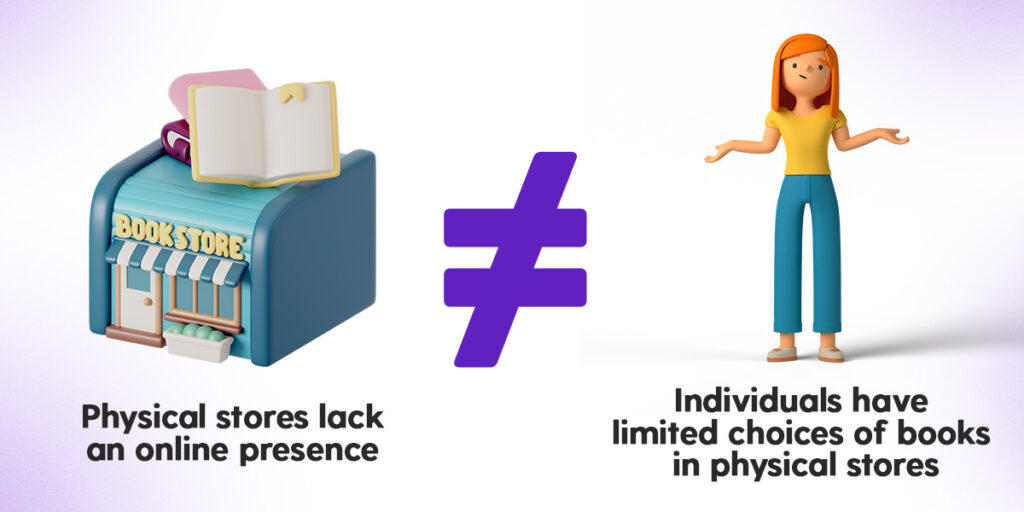
To find an idea for a B2C marketplace, you can consider solving problems for buyers and sellers with a niche marketplace or by developing a solution for passionate, underserved communities.
For inspiration, you can think about the different types of marketplace e.g. product, service or rental and how the structure of each of these different types of marketplaces can be utilized to take advantage of current trends. For example, you could consider a rental marketplace to solve problems for consumers looking for short term use of property without ownership. This might include amateur film makers who need access to expensive equipment for a limited period or travellers seeking unique accommodations for their vacations.
From our experience, the most important thing is to find an idea that resonates with your personal passions. This is pivotal to building a great B2C marketplace platform since genuine passion and enthusiasm will fuel your commitment, creativity, and determination to overcome challenges that come up while building your solution.
To learn more, read how to come up with a great marketplace idea.
Step 2. Validate your idea
Once you have an idea for a new B2C marketplace platform, the next step is to validate that there is a market for your idea. This is a crucial step that you should take before investing huge amounts of time and resources into your marketplace development.
Idea validation essentially involves finding target users and gathering evidence that proves there is a genuine demand for the marketplace. There are five popular steps that you can take to validate your idea. These are:
- Test any risky assumptions that you’re making about your market
- Assess your market size and share
- Research search volumes for related keywords
- Conduct customer validation interviews
- Build the first version of your marketplace
To test out your B2C marketplace idea it is essential to speak with real potential customers early on. You can find these people either using online or offline channels.
Online channels include Facebook groups, forums, or industry-specific communities where you can engage with target users and gather valuable insights into their needs, preferences, and pain points.
Offline channels include physical meetups such as networking events, or trade shows. Meeting potential customers face-to-face allows for deeper conversations and the opportunity to build more lasting relationships, gaining a deeper understanding of customer motivations and behaviour.
For more information on how to validate your marketplace idea, read our article, how to validate your marketplace business idea.
Step 3. Choose a marketplace business model
A successful B2C marketplace platform needs a sustainable business model. Marketplaces have eight primary business models. These are:
- Commission model
- Subscription revenue model
- Listing fee model
- Lead fee model
- Freemium model
- Ads and featured listings model
- Data licensing model
- Mixed revenue model
By far the most popular revenue model for B2C marketplace platforms is the commission model. In the commission model, the marketplace makes revenue by charging a commission, also known as a transaction fee, take rate or rake, when connecting businesses to consumers.

The commission model stands out as a popular choice, as neither the business nor the consumer incurs any initial costs to join the marketplace, which can facilitate early user adoption. Therefore, we recommend starting with the commission model, unless there are compelling reasons not to.
For the rest of this section we focus on how to set up the commission model for B2C marketplaces. For more information on marketplace business models, read the top marketplace business models.
Who and what to charge?
When implementing the commission model, you need to decide who to charge the transaction fee to and how much commission you’re going to charge to that person.
Who to charge?
The commission fee can be charged on either the supply side (to the business), on the demand side (to the customer) or on both sides. But which side is it best to charge this to?
As a rule of thumb you want to charge the commission to the side that is least constrained. So – if it’s harder to find businesses to list products and services on your platform, then it is better to charge the commission to the customer, whereas if you find it harder to get customers onboard, it’s better to charge the commission to the buyer.
What to charge?
There is no one pricing strategy that works for all B2C marketplace platforms. The rate that you can set boils down to the market that you’re after. This is because all markets have different marginal costs, levels of competition, demand and supply differentiation, transaction size and volume and network effects.
Let’s break down each of these points quickly.
Marginal costs
Businesses that list their products or services on a B2C marketplace platform have different costs. These costs impact how much profit the business makes per unit of product or service that they sell.
For example, let’s imagine a scenario where we run a B2C marketplace for restaurants to connect their chefs on-demand with private individuals. In this case, the restaurant business may offer their services at $300 per cooking session on our fictional B2C marketplace platform. However, behind this rate lies various marginal costs inherent to their restaurant business. These expenses typically encompass ingredients, kitchen equipment maintenance, transportation, and the chef’s time. If we estimate these costs at $120 per session, the restaurant’s profit margin per session amounts to $180.
Now, let’s consider the impact of our marketplace’s commission structure. At a 20% commission rate, the restaurant would retain $120 per session, which might be considered reasonable given their expenses. However, if our B2C marketplace platform increases its commission to 50%, the restaurant’s earnings will drop to $30 per session. This significant reduction may prompt restaurants to reassess their participation on our platform, especially if it compromises their financial viability.
As such, when setting the commission rate for your B2C marketplace platform, you absolutely must aim to strike a balance between the commission structure for both the business and consumers to ensure that the platform is financially appealing.
Levels of competition
If your B2C marketplace platform is in a space that is heavily competitive, this can make it very difficult to charge high commissions. This is because competitive pressures generally force B2C marketplaces to lower the commission rate that they charge so as to attract and retain businesses and consumers. Competition can from direct competitors e.g. B2C marketplaces doing the same thing as you, or established businesses that already have a smooth way to connect with their customers.
In contrast, in a less competitive market where there are fewer alternatives, B2C marketplaces may have more flexibility to set higher commission fees without fear of losing either businesses or clients. Overall, you should consider the level of competition and use this as a metric to adjust your B2C marketplace take rates.
Demand and supply differentiation
Do your businesses and consumers differ in the way they interact on your platform? For instance, do you see that some businesses transact smaller amounts less frequently than others? Do you want to charge them the same amount?
Network effects
As we have already seen, 2-sided marketplace network effects are where the value really lives in a B2C marketplace platform. Generally speaking, the higher your network effect, the higher value your marketplace and the more you can charge businesses and consumers to use your B2C marketplace platform.
B2C marketplace business models: Some final thoughts
The biggest contributor to the amount you can charge is the value that your marketplace provides. This value is likely to increase over time as you learn to better service your customers and your marketplace starts to experience network effects.
In the early days, you may want to offer discounts to businesses or consumers in order to get them to sign up and refer others. Meanwhile, most mature marketplaces such as Amazon, Rakutan, Target and so on use mixed business models with (for instance) a subscription fee charged for access to tools designed to help businesses or individuals get more out of the platform. For example, Amazon gives individuals the option to subscribe to Amazon Prime for additional benefits such as next day delivery whilst businesses have a choice to pay a subscription fee for additional tools designed to help sellers grow.
Step 4. Choose your tech stack
Once you’ve validated your idea and chosen a business model, it’s time to choose a technology to build your B2C marketplace with.
There are four components to a tech stack:
- Frontend user interface. This is the bit of your B2C marketplace that your users will see. The frontend is build out of frontend programming languages such as HTML, CSS and JavaScript for the web or Android and iOS Software Develpment-Kits for the mobile phone.
- Backend application. This is the bit of your marketplace that handles the logic for the marketplace. It is developed using a backend programming language such as Google Go.
- Database. This is the bit of the application that stores the data for your marketplace. Common choices will might be PostgreSQL or MySQL.
- Server. This is used to host your marketplace application. Typically this will be hosted in either Amazon Web Services (AWS), Google Cloud Platform (GCP) or Microsoft Azure.
For more information on what the core components are of your tech stack see what is backend app development.
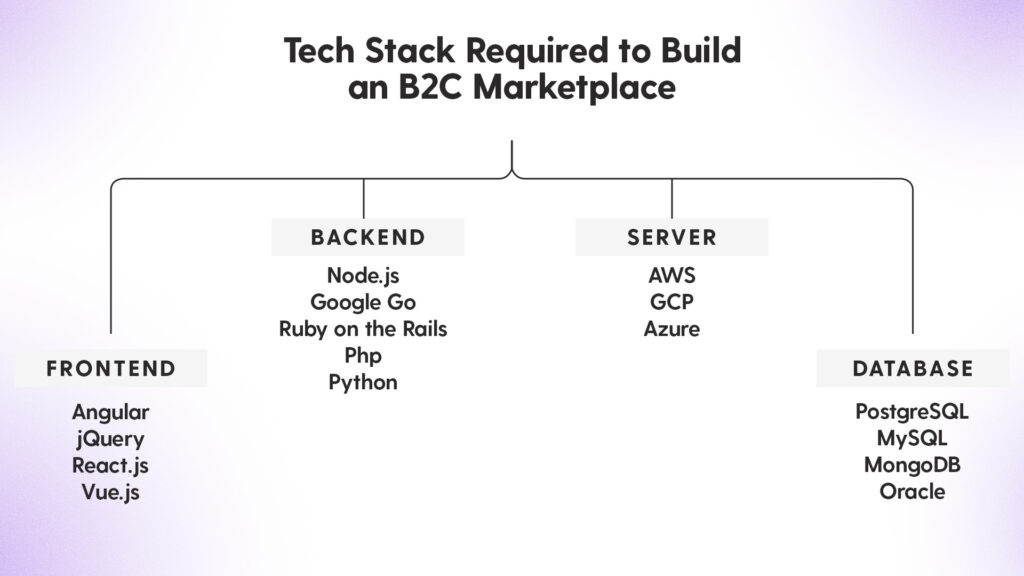
Some key things to consider when choosing your tech stack are speed of development, flexibility, the development team and marketplace hosting. Let’s take a quick look at each of these now.
Speed of development
Good B2C marketplaces are rarely built in isolation. Rather they are developed through a collaborative process between businesses, customers and the marketplace platform. This is achieved through a process of continual product iteration that begins by launching your marketplace fast and then making changes to it quickly, based on customer feedback.
Opting for a technology stack that’s sluggish and costly to develop, launch, and iterate can drain your budget rapidly. Therefore, we recommend leveraging marketplace technology to construct your marketplace within the initial 30 days.
By selecting a marketplace technology equipped with a visual development tool (like Dittofi’s no code marketplace builder), you can seamlessly refine your marketplace swiftly and affordably, guaranteeing continued adaptation.
Flexibility
The only certainty in business is change and, due to advances in visual development tools and generative AI, the pace of chance is increasing. Therefore, it is absolutely essential that you choose a technology stack that allows you to continually adapt to whatever the market throws at you.
As a consequence, it is imperative that you have control and access over the source code that powers your B2C marketplace. This will naturally be the case if you code from scratch however, if you’re considering use a marketplace technology, make sure that you choose one that has a code export feature.
Choosing a team of marketplace developers
Unless you have a lot of experience, we advise you work with a team to help build your B2C marketplace.
It is really important that you choose a quality multidisciplinary team. with a track record of successfully building a B2C marketplace platform. This will allow the team create a development roadmap that strategically corresponds to your timeline of business objectives.
Check out our article, how to choose your marketplace development team for a guide on how to find the best marketplace engineers for your project.
Marketplace hosting
The cloud native approach to marketplace hosting is the future. Depending on how you architect your marketplace hosting, this can become a competitive advantage for your organization or a total disaster.
When looking into marketplace hosting options, you should start first by thinking about where to host your marketplace. To do this, you need a hosting provider such as Google Cloud, Amazon Web Services, Microsoft Azure or any other niche provider.
When choosing a hosting provider, you should consider what is the ongoing cost of hosting your marketplace going to be and what is the cost of setting up and maintaining the hosting.
Building your own marketplace hosting properly will cost you more than $1 million. However, there are platforms such as Dittofi’s Automated DevOps Solution that can help you deploy your marketplace into a highly scalable hosting environments in just a single click and for a fraction of the price of traditional marketplace hosting.
Step 5. Build and launch your marketplace MVP
At this stage, you have validated your idea and decided on a B2C marketplace business model.
You’ve also chosen a technology stack and team to build your B2C marketplace platform.
However, it is difficult to know how businesses and consumers are going to react when you put your marketplace in front of them. Will they be able to easily sign up and onboard? Or will there be friction in the sign up process? Will the platform pricing make sense for your target market? Or will it prevent adoption and need to be updated?
To answer these questions, you need to build B2C marketplace MVP (Minimum Viable Product).
The goal at this stage of your B2C marketplace journey is to build and launch your MVP as quickly as possible. Get it in front of real users, so that you can learn if your marketplace is able to help these users or not. The MVP can also help you to start earning some revenue.
How to build a B2C marketplace MVP
Your B2C marketplace MVP should be the core business to consumer functionality that makes your users love using your website and nothing more.
The best advice for B2C marketplace creators is to launch your marketplace MVP fast and then, rapidly adjust your marketplace based on customer feedback.
When building your B2C marketplace MVP, your mindset needs to be that you only really start learning about user when you put your product in front of them.
The majority of times B2C marketplace founders either fail to launch a product or, fail to iterate on their version 1. There are many reasons for this ranging including founder fear, high development costs or lack of experience from the development team.
At Dittofi we have created a no code marketplace solution that helps you to build and launch a marketplace in under 10 hours. The solution includes a prebuilt, B2C marketplace template, that you can install directly into our visual development studio. From inside the studio, you can then rapidly customize and launch the solution in an entirely visual way. Dittofi then translates your visual designs into enterprise grade code that you can either deploy into a fully managed marketplace hosting model or export and hand off to developers.
Critically Dittofi allows you to own the source code for your marketplace, giving you total flexibility and control over your technology. The image below shows Dittofi’s B2C marketplace platform and example of the features that are included.
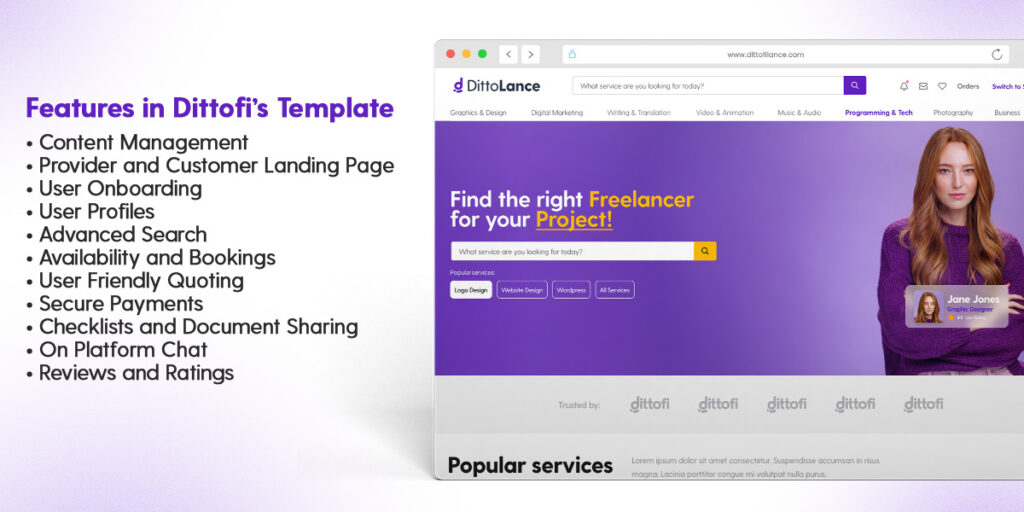
Dittofi is a great alternative to building a B2C marketplace from scratch using custom code. This is because, we save you time and money, by giving you all of the essential features for your marketplace on day one. This can save you 3 – 6 months of development time and approximately $50k – $100k of development costs.
We also give you complete ownership over your marketplace’s source code. This means you can access and control every line of custom code for your marketplace. As such Dittofi’s marketplace solution is fundamentally the same as custom code, but without the wait time.
Finally, Dittofi comes with an advanced visual development studio that you can use to quickly iterate and customize your marketplace without coding thereby reducing dependency on expensive development teams. The platform includes tools to help you customize your marketplace without coding and to scale your code with tools for professional development teams.
Onboard your early adopters
Now that your B2C marketplace MVP is live, it is time to start onboarding users.
For marketplaces finding early adopters can be tricky. This is because, without businesses offering out their products or services, there is very little incentive for consumers to sign up. Meanwhile, without consumers, businesses have no one to showcase their products or services to. This problem is known as the marketplace chicken and egg problem.
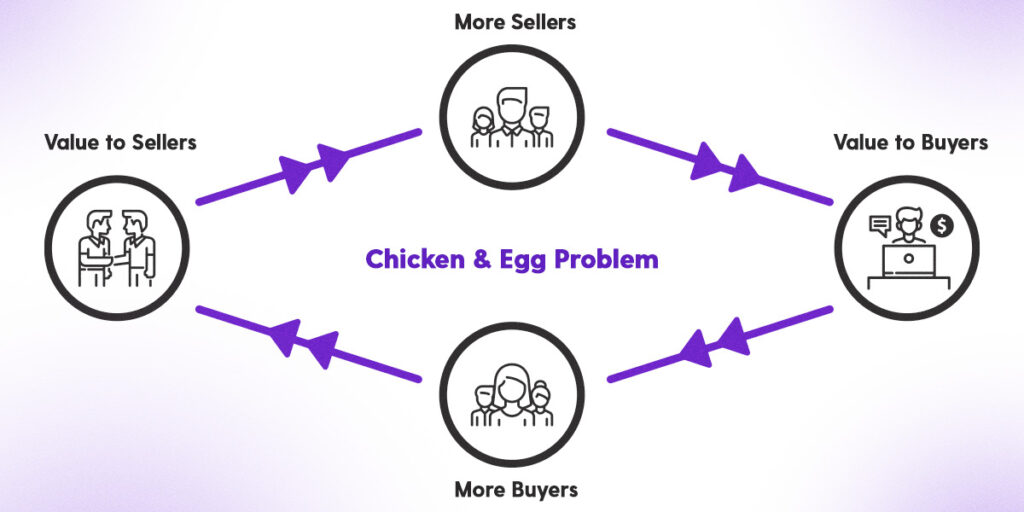
There are many different tactics on how best to solve the marketplace chicken and egg problem.
In July 2019, five time marketplace founder James Currier, gave us 19 tactics to solve the chicken and egg problem. A selection of these are shown below.
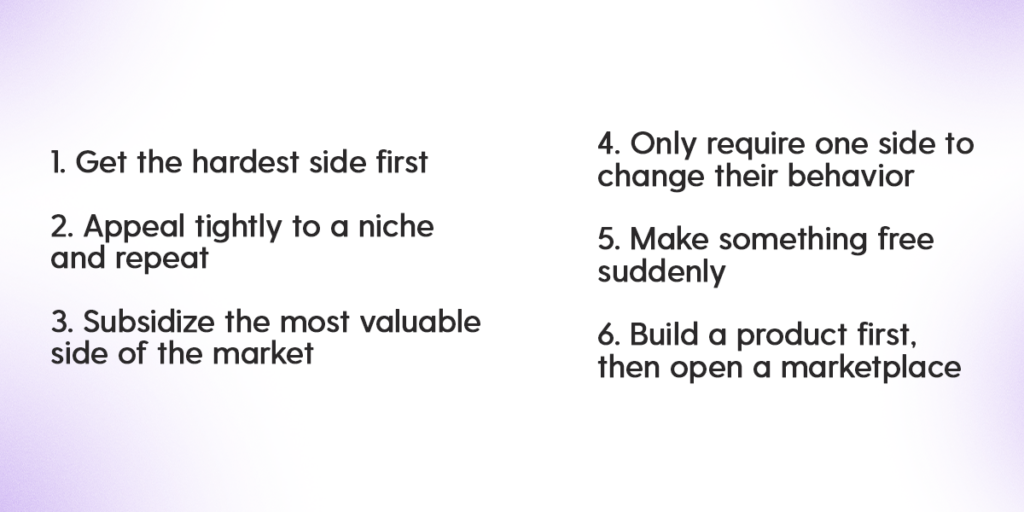
The most important takeaway from this presentation is that, it is best to start by onboarding the hardest side first. Usually the hardest side is the consumer side (demand) since, when there is a high demand for products or services from individuals, businesses will naturally show up in order to list their products for sale.
Counter to this, most marketplaces start with the businesses (supply-side) first. This is because it is much easier to convince a business to list their products or services on your marketplace with the promise of leads. However, unless you can actually drive consumer demand to your B2C marketplace site, businesses will quickly abandon your platform in favour of alternatives.
Step 6. Learn and grow
Now that you have early adopters using your marketplace, it is time to start watching very closely how they use your product. Do businesses get stuck uploading their catalogues of products? Are your buyers able to easily find what they’re looking for? How can you keep providing value so that you differentiate yourself from competitors?
At this point in your B2C marketplace journey, you need to make rapid adjustments to your platform. This is the right time to start investing heavily in your technology.
The changes you make should be carefully chosen from your customer feedback. This is know as customer driven development. By following a cycle of constant itreation based on your customer feedback will not only enable you to retain your early adopters and encourage repeat transactions, it will also help you develop a marketplace flywheel effect which is what will help you find exponential growth.
This process of iteration based on customer feedback is shown below.
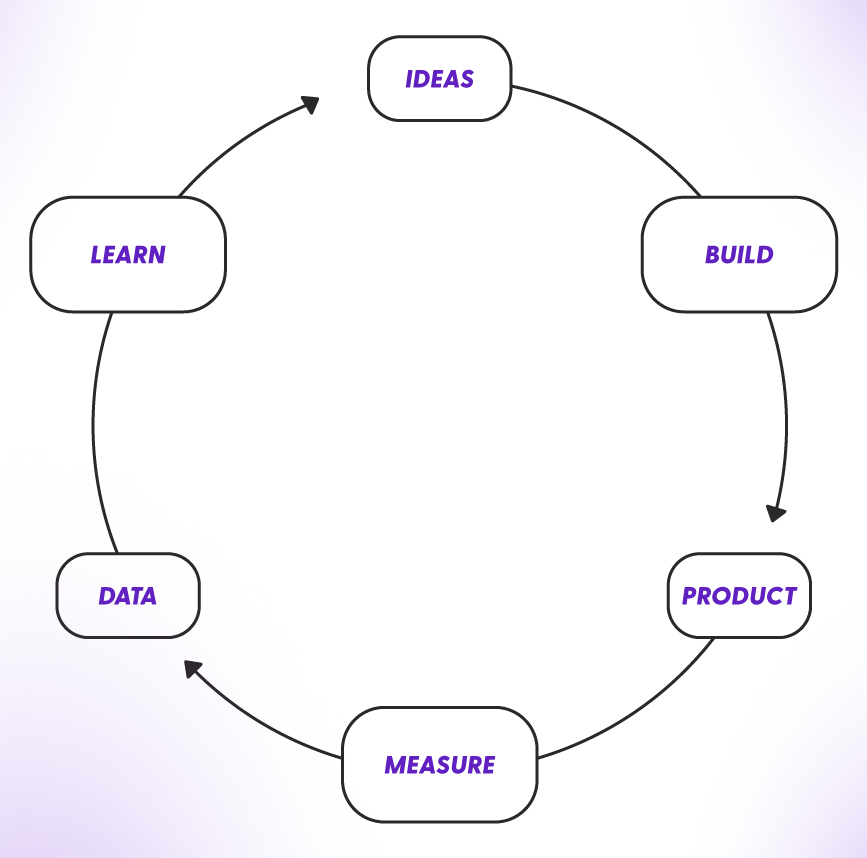
One question we often get is, “how often should you release a new version of my marketplace?”. The answer depends on several factors however, we’ve found the faster you can release new features the better you will retain users.
B2C marketplace development platforms like Dittofi come with built in code deployment pipelines, testing and automated devops processes. These solutions can significantly speed up the time it takes to deploy new features into production. Alternatively, if you choose to code from scratch, it’s important to allow some time to implement adequate devops processes that will aid in more speedy deployment.
Scaling up the development team to add new features faster is an art form. This is typically where we see founding teams and more junior development teams come unstuck. Remember – adding more hands will not necessarily result in faster development.
How much does it cost to build a B2C marketplace platform?
The cost of building a B2C marketplace platform varies depending on the skill set of the team you employee, the technology you use and your level of experience.
Broadly speaking, if you are a building a B2C marketplace platform for the first time, there are two main costs that you will incur in the first year: marketing and development.
The cost of B2C marketplace development
B2C marketplace platforms are complex.
Even version 1 of your marketplace needs to have a lot of carefully designed features just for a basic transaction flow whereby businesses can list catalogues of products or services and consumers can view and purchase these listings. To give some idea of the complexity of implementing a transaction flow consider the following diagram.
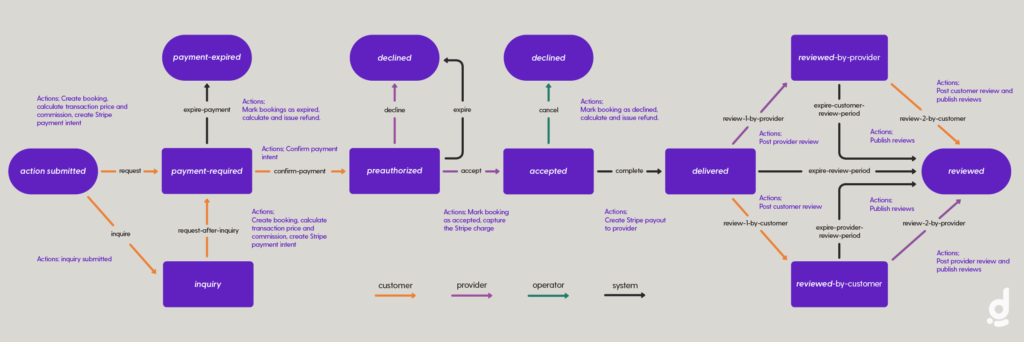
This transaction flow explains how the businesses and customers interact with each other. It start by a user submitting either a message to inquire about an item listed on the marketplace or to make a payment for the item. The transaction flow ends with a two-sided review where both business and customer have the opportunity to review elements of the transaction such as product quality, communication, price and so on.
Designing and developing a transaction flow like this from scratch is incredibly detailed, time consuming and expensive. It requires skilled product designers, software engineers and testers. These hires should have familiarity with the complexities involved in developing a B2C marketplace. This will ensure that your B2C marketplace works according to industry best practices when delivered.
In addition, your development team should have experience writing scalable code and implementing this is a sustainable way.
Of course finding and hiring a team of people with this level of expertise is difficult and expensive. Typically you should expect to pay anywhere between $50,000 – $250,000 over a period of 3 – 6 months, just to get started. The lower the price you pay, generally the lower the level of experience.
By contrast, platforms such as Dittofi have have been purpose built so that you can develop an enterprise grade B2C marketplace at a fraction of the time and cost compared to traditional development. Dittofi works by enabling you to first of all install a prebuilt, feature rich, B2C marketplace template for either a product, rental or service B2C marketplace. This template brings you all of the features that you need to develop an enterprise grade marketplace.
Once installed, you can rapidly customize Dittofi’s templates from within Dittofi’s visual design studio – without writing any code. Dittofi then transforms your visual designs into simple, secure and scale code that you can either deploy in one click or hand off to developers.
Below is a cost and time comparison between Dittofi’s methodology vs traditional coding.
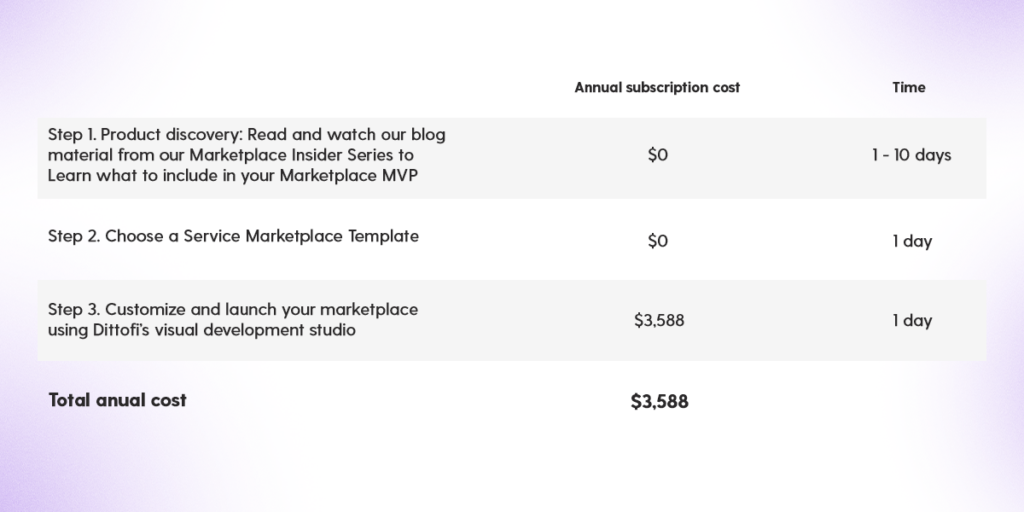
Furthermore, the code that Dittofi generates is high performance and quality code, generated on a modern scalable tech stack (React and Google Go).
The cost of marketing and user acquisition
In addition to the development costs, you also need to think about how you’re going to attract businesses and consumers to your marketplace. To do this, you need to use a combination of paid and unpaid channels.
There are many different ways to market your B2C marketplace however, in the early days it is best to use unpaid channels. This will help you connect with your users and learn what content works best for them.
Once you understand what content works best in attracting businesses and consumers, you can then invest in paid channels for these pieces of content.
Below is a rough budget of what you can expect to spend in year one on your B2C marketplace.
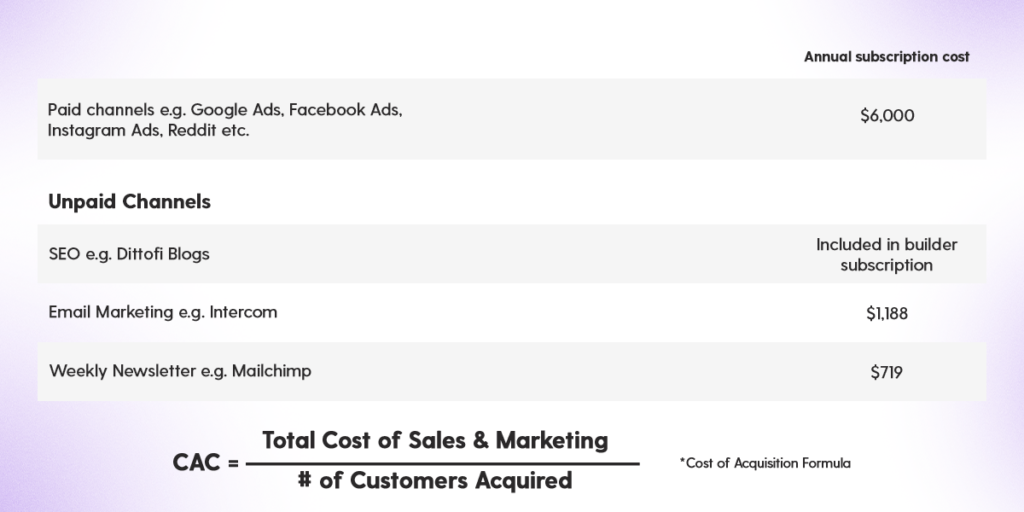
Conclusion: Building your B2C marketplace business
Building a B2C marketplace can seem daunting.
But don’t let this hold you back.
Take it in stages, as outlined in this article and be willing to work hard to make it a success.
Remember, great B2C marketplaces don’t take off by accident. Rather, it’s the founders of the organization that make the business take off through hard work, determination and a willingness to accept and learn from their mistakes.
To give yourself the best chance of success we strongly advise that you launch your B2C marketplace early and often. Focus on building features that your customers are asking for and fully embrace the iterative approach.
Above all remember – a good product is rarely built in isolation. Rather it is the result of collaboration between platform creators and their clients.
If you’re interested to learn more about how to build a B2C marketplace platform, book a call with one of our marketplace specialists for a free 45 minute consultation.
And… as always… in case we don’t speak, best of luck with your B2C marketplace platform development, we’re rooting for your success!

